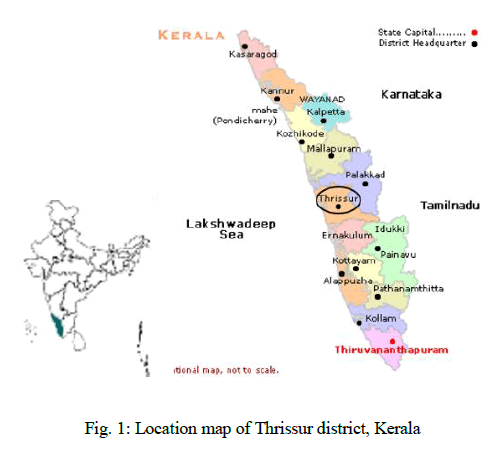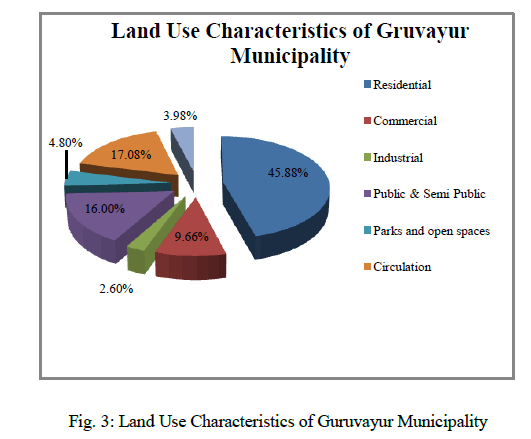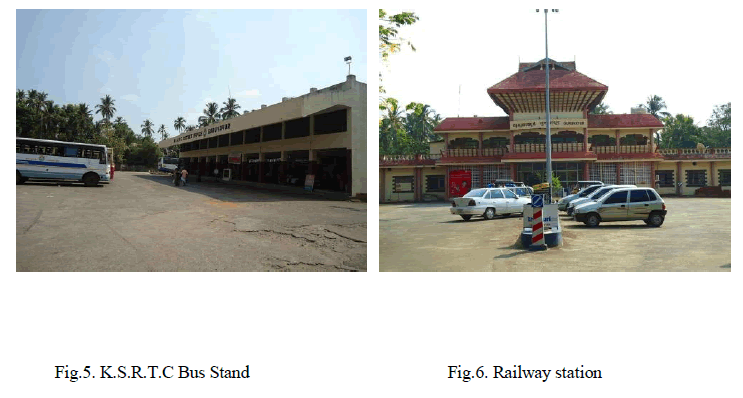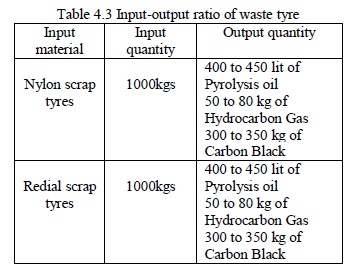ISSN ONLINE(2319-8753)PRINT(2347-6710)
ISSN ONLINE(2319-8753)PRINT(2347-6710)
| D.Arivukkarasu, T.S.Lakshmi Department of Civil Engineering, GRT Institute of Engineering and Technology, Tiruttani-631209, Tiruvallur Dist, Tamilnadu, India |
| Related article at Pubmed, Scholar Google |
Visit for more related articles at International Journal of Innovative Research in Science, Engineering and Technology
Solid Waste is one of the major environmental problems of Indian cities. The quantity of solid waste produced in city depends on the type of the city, its population, living standards of the residents and degree of commercialization, industrialization and various activities prevailing in the city. Solid Waste Management is an obligatory function of municipal corporations, municipalities and other local bodies in India. Waste quantities are increasing and municipal authorities are not able to upgrade the facilities required for proper management of such wastes. In many cities and towns, garbage is littered on roads and foot-paths; almost 90% of Solid waste is disposed of unscientifically in open dumps and landfills, creating problems to public health and the environment. This study is carried out on Municipal solid waste management practice by five major municipalities of Tiruvallur District. This study includes review of the waste generation, characterization, collection, transportation, disposal of MSW, Government participation and available income to government through municipal solid wastes. Survey has been conducted to know the public participation towards municipal solid waste management. Some locations were identified for setting up Transfer stations for handling municipal solid waste and sanitary Landfill sites for safe disposal of solid wastes, treatment technologies for MSW along with their benefits, remedial measures and suggestions on future MSWM strategies were also discussed. This study also aims at encouraging authorities/researchers to work towards the improvement of the present system through suggestions, recommendations and also to create awareness among each individual to make pollution free environment.
Keywords |
| Municipal Solid waste, waste generation, transfer station, landfill site. |
INTRODUCTION |
| The quantity of municipal solid wastes generated in Tiruvallur has been consistently rising over the years. This can be attributed to the rapid population growth, mass migration of population from rural to urban areas, Rapid industrialization and increase in economic activities in general in the city and the change in lifestyle of the people. As per report (May 2000) of Ministry of Urban Development (MoUD), Government of India that 1,00,000 MT of Municipal Solid Waste was generated daily in the country. The survey conducted by the central institute of Plastics Engineering and technology (CIPET) at the instance of CPCB has reported generation of 50,592 tonnes of MSW per day in the year 2010-11 in same 59 cities. |
| The MSW quantity is expected to increase significantly by the year 2020 due to the growth in population, living standards of the residents and degree of commercialization, industrialization and various activities prevailing in Tiruvallur district. Inefficient management and disposal of municipal solid waste is an obvious cause for degradation of environment in the developing countries. Ecological impacts such as land degradation, water and air pollution are related with improper management of municipal solid waste. In developing countries, most of the municipal solid waste is dumped on land in more or less uncontrolled manner. As a result there is a serious threat to public health due to environmental pollution. This paper describes analyses the correlation analysis of among various factors of municipal solid waste generation and also estimates the future amount of municipal solid waste generation. Finally, the future land area required for landfill site disposal in Tiruvallur district. |
1.1 Solid waste management at Tiruvallur district. |
| The present management of solid waste at Tiruvallur district involves four steps. They are: |
| 1. Generation and Composition of Waste |
| 2. Collection of Waste |
| 3. Transportation of Waste |
| 4. Disposal of Waste |
| Solid waste management is one of the most essential functions in a country to achieve a sustainable development. The most common ways to treat waste in India today are open dumping and uncontrolled burning. These methods are causing severe environmental pollution and health problems. India is one of the world’s largest emitter of methane gas from waste disposal. Improper treatment of waste will also affect peoples’ health. |
| When waste is incinerated in an incineration plant there are many environmental benefits. First of all, the possibility of using flue gas treatment prevents emissions of toxic compounds to emit to the air compared to if waste is burnt uncontrolled. Secondly, the amount of waste going to the dumpsite will decrease, resulting in a reduction of methane formation and less leakage of sewage from the dumpsite to the groundwater. |
STUDY AREA |
| The MSWM study has been carried out in Tiruvallur district municipalities. There are Five Municipalities in Tiiruvallur district as mentioned below: |
| 1. Tiruttani |
| 2. Tiruvallur |
| 3. Avadi |
| 4. Poonamallee |
| 5. Thiruverkadu. |
2.1 Present Practice of Solid Waste Management at Tiruvallur District. |
| The proper collection and disposal of Solid waste without causing any harm to the environment is collectively termed as the solid waste management. The management of solid waste involves four steps; |
| 1. Generation and Composition of Waste |
| 2. Collection of Waste |
| 3. Transportation of Waste |
| 4. Disposal of Waste |
2.1.1 Generation and Composition of Waste |
| Municipal solid waste (MSW) is a waste type that includes predominantly residential sometimes the addition of commercial wastes, construction and demolition debris, sanitation residue, and waste from streets collected by a municipality within a given area. |
2.1.2 Collection of solid waste: |
| In Tiruvallur district, Municipal Solid waste is collected through traditional handcarts/tricycles that can carry only a small quantity of waste at a time. Generally, open sites or round cement concrete bins, masonry bins are used for temporary bulk storage. Waste often spills over which is both unsightly as well as unhygienic and causes health effects. |
2.1.3 Transportation of solid waste: |
| Transportation of waste from the waste storage depots to the disposal site is done through a variety of vehicles such as bullock carts, threewheelers, tractors, and trucks. A few Municipalities use modern hydraulic vehicles as well. Most of the transport vehicles are old and open. They are usually loaded manually. |
2.1.4 Disposal of solid waste: |
| Disposal of waste is the most neglected area of SWM services and the current practices are unscientific. Almost all municipal authorities deposit solid waste at a dump-yard situated within or outside the city and do not bother to spread and cover the waste with inert material. These disposal sites often cause foul smell and become breeding grounds for flies, rodent, and pests. Liquid seeping through the rotting organic waste called leachate pollutes underground water and poses a serious threat to health and environment. |
MATERIALS AND METHODOLOGY |
 |
 |
3.1 Drawbacks of the Present system |
| • No segregation of waste at source |
| • No system of primary collection from door steps |
| • Irregular street sweeping |
| • Irregular transport of waste in open vehicles |
| • No partition is provided in the vehicle to separate the bio degradable waste and non-bio degradable waste |
| • No Segregation and Processing of waste |
| • No Transfer station |
| • Not using technological treatments in SWM |
| • Inappropriate disposal of waste at open dumping grounds |
| • Landfill area is not allocated |
| • Disposal of waste, current practices are grossly unscientific. |
| 3.2 Implementation required on MSWM in Tiruvallur district |
3.2.1 Reduce, Reuse, Recycle (3R) |
| Methods of waste reduction, waste reuse and recycling are the preferred options when managing waste. There are many environmental benefits that can be derived from the use of these methods. They reduce or prevent greenhouse gas emissions, reduce the release of pollutants, conserve resources, save energy and reduce the demand for waste treatment technology and landfill space. Therefore it is advisable that these methods be adopted and incorporated as part of the waste management plan. |
3.2.2 Waste reduction and reuse |
| Waste reduction and reuse of products are both methods of waste prevention. They eliminate the production of waste at the source of usual generation and reduce the demands for large scale treatment and disposal facilities. Methods of waste reduction include manufacturing products with less packaging, encouraging customers to bring their own reusable bags for packaging, encouraging the public to choose reusable products such as cloth napkins and reusable plastic and glass containers, backyard composting and sharing and donating any unwanted items rather than discarding them. All of the methods of waste prevention mentioned require public participation. In order to get the public awareness, training and educational programmes need to be conducted to educate the public about their role in the solid waste management. Also the government need to ban the usage of plastic bags and plastic products. |
 |
Recycling |
| Recycling refers to the removal of items from the waste stream to be used as raw materials in the manufacture of new products. Thus from this definition recycling occurs in three phases: first the waste is sorted and recyclables collected, the recyclables are used to create raw materials. These raw materials are then used in the production of new products. |
| Almost every material can be recycled; however, the value of the recycled material can vary significantly depending on the demand and uses for it. Indeed the value of a material is the driving factors for private recycling initiatives or in the case of many developing countries the informal sector. If and how a material is recycled depends not only on local policies but also on the availability of a buyer, processing facilities, and a transport chain. |
RESULT AND DISCUSSION |
4.1 Comparison between Existing and Proposed MSWM |
 |
4.2 Income to government through MSWM |
 |
| In Tiruvallur district total waste generated about 252 TPD from five municipalities, hence the recyclable and reusable wastes can be segregated in the range of 8% of total waste as shown in fig.4.3. 20.16 TPD is obtained from 8% of total waste. Approximately waste composition of about 100 houses per day can provide income shown in table 4.2 |
 |
| The total income can be earned per day Rs.13, 81,842 approximately for the total population of 5 district municipalities about 5, 59,450. |
4.3 Wastes to Electricity - Incineration |
| The electricity generated from MSW is first the waste materials are segregated. The MSW will be segregated into the following fractions: recyclables, inert material, compostable fractions and burnable waste. The segregation is made both manually and mechanically. The incoming waste is initially weighted on a weight bridge, tipped on a tipping ground and then processed as shown in fig.4.6. |
 |
| The compostable and inert components are segregated and processed to compost and bricks respectively. The burnable material is separated and chopped to Refuse Derived Fuel (RDF) which can be used in a boiler to produce electricity. |
4.4 Waste to Oil and Grease – pyrolysis |
4.4.1 Pyrolysis Process |
| Pyrolysis can be used to reprocess the tyres into fuel gas, fuel oil, solid residue (steel wire) and carbon black. A pyrolysis method which produces activated carbon and high-grade carbon black. The waste tyres are mainly composed of long chain of C-H molecules. The major source is from process of pyrolysis, separation and compounding of Oil. The technology of pyrolysis, cracking, and monomerisation of used tyres is always a hot topic. |
 |
4.5 Wastes to Biogas |
| According to Dr. P.K.Balasankari and Arul Joe Mathias articles “EMERGING ASIAN TREND IN COMMERCIAL POWER GENERATION FROM MSW” |
| MSW to biogas is one of the new concepts in the management of MSW. Developed countries have taken the lead to treat the bio-degradable MSW through anaerobic digestion. The sludge from anaerobic digestion can be sold as manure. Other major advantage of MSW to biogas is the reduced land requirement. Compared to landfill, the size of MSW biogas plant is very small. |
| In our district we have 20% of compost wastes in total waste about 252 TPD. It means that the organic waste in tonnes about 50.4 tonnes per day. Hence we can obtain the bio gas about 5040 m3. |
CONCLUSION |
| Municipal solid waste management varies widely among different countries and regions. Most of the management services are often provided by local government authorities, or by private companies in the industry. This can be done through the application of waste hierarchy which refers to the "3 Rs" reduce, reuse and recycle. This hierarchy classifies waste management strategies according to their desirability in terms of waste minimization aimed at extracting the maximum practical benefits from products and to generate the minimum amount of waste. The study had carried out at municipalities in Tiruvallur and analyzed the disadvantages in the present Solid waste management system. This study recommends a better MSWM strategies and economical integrated SWM system. The proposed Municipal Solid Waste Management system provides better waste handling and processing and also provides various economic strategies from MSW. People have lack of knowledge about impact of MSW hence they required awareness and training for their involvement to overcome various environment and health hazards due to improper disposal of waste. The government should undertake the SWM for better implementation to protect our environment and public health. Also found approximate available revenue to government of about Rs.13, 81,842 from solid wastes. The possible electricity generation from Municipal Solid waste of five municipalities is found about 1.8 MW per day using RDF by Incineration process. Bio-gas can be obtained about 5040 m3, Organic Manure of about 25200 kg per day can be produced by various composting techniques. Rather than considering the municipal solid waste simply as residue to be thrown away, it should be recognized as resource materials for the production of energy, compost and fuel depending upon the techno-economical viability, local condition and sustainability of the project on long term basis. |
References |
|